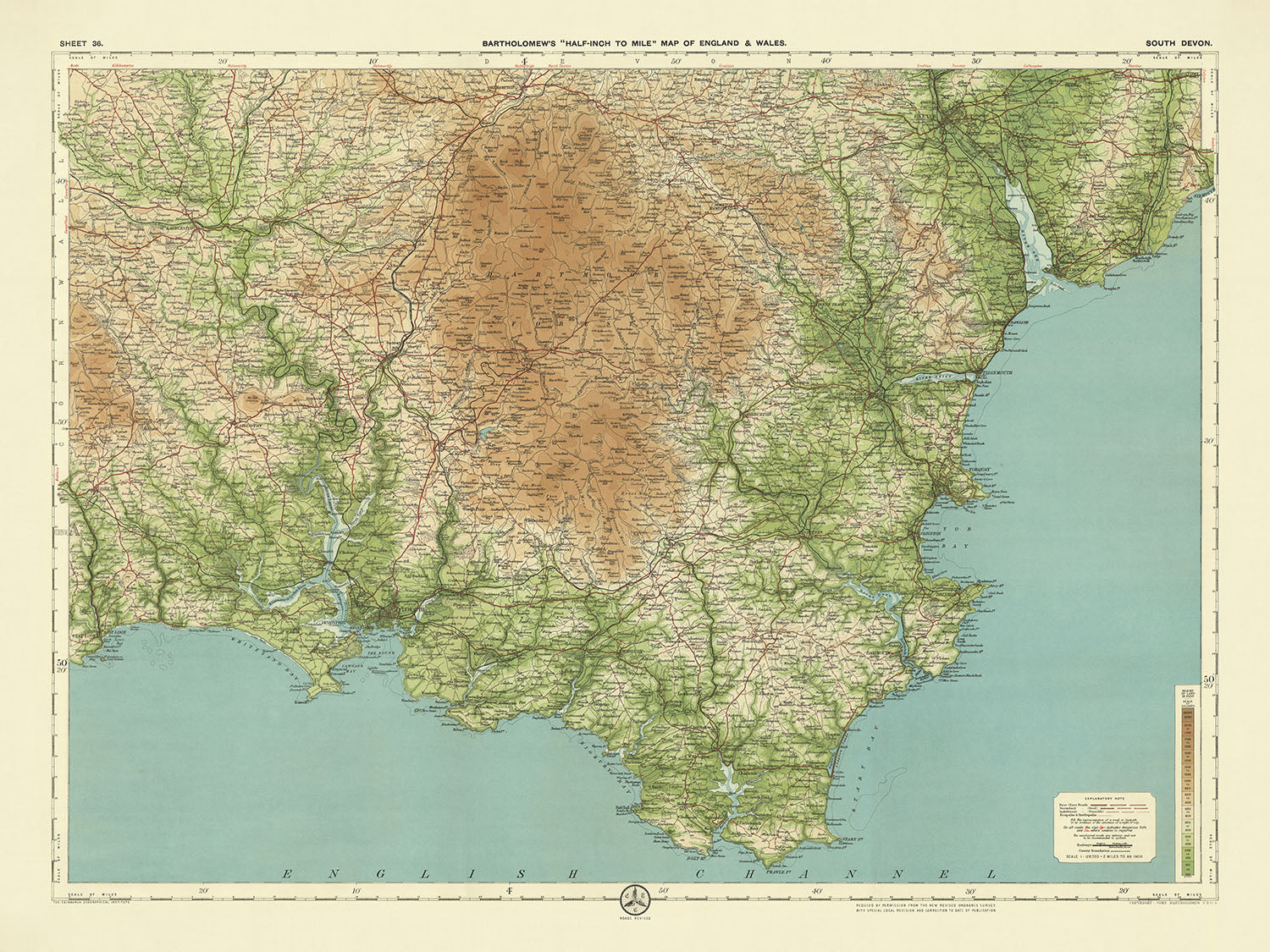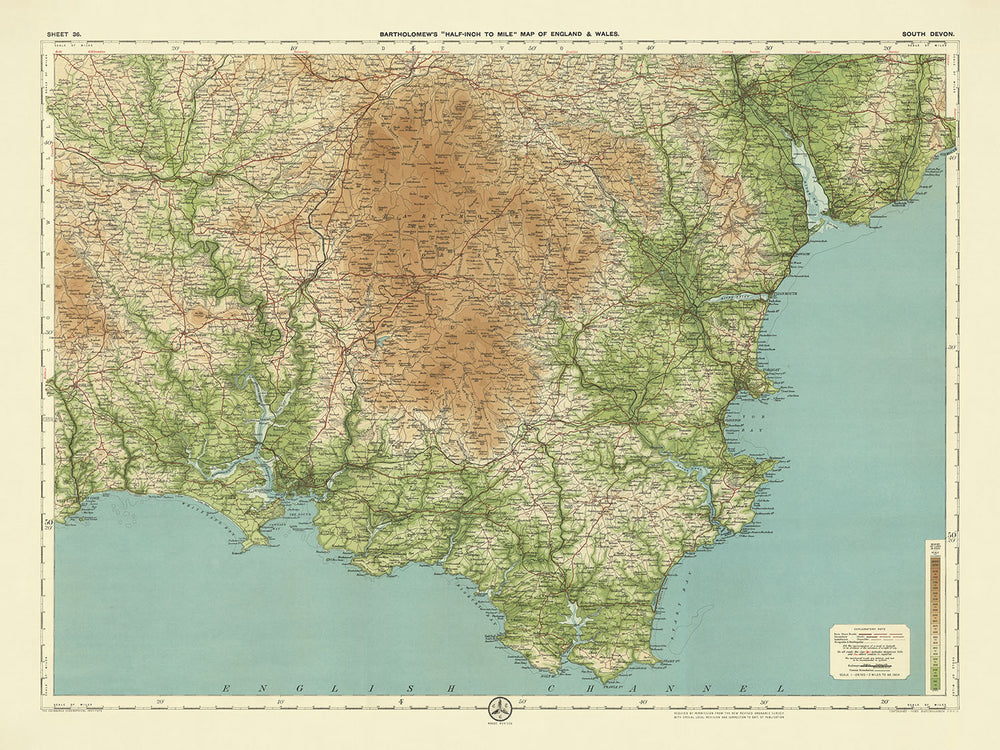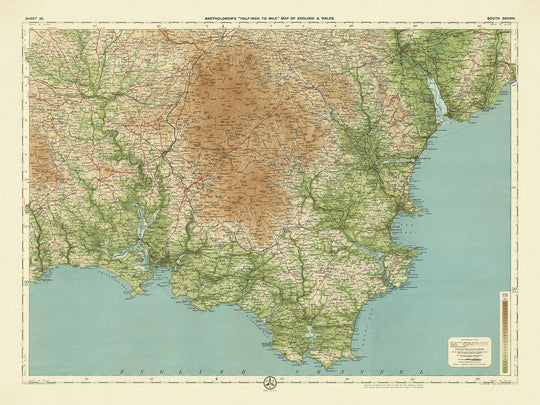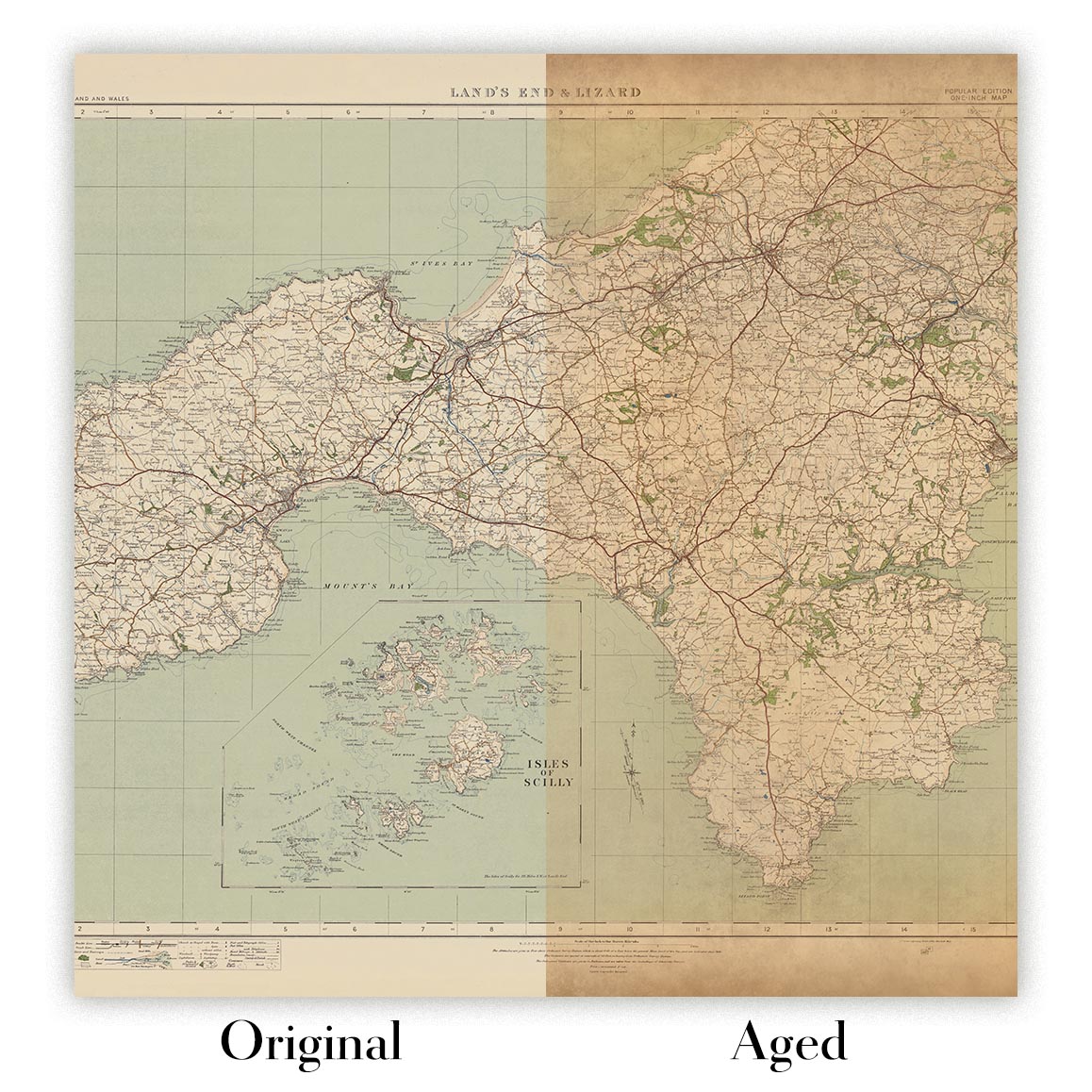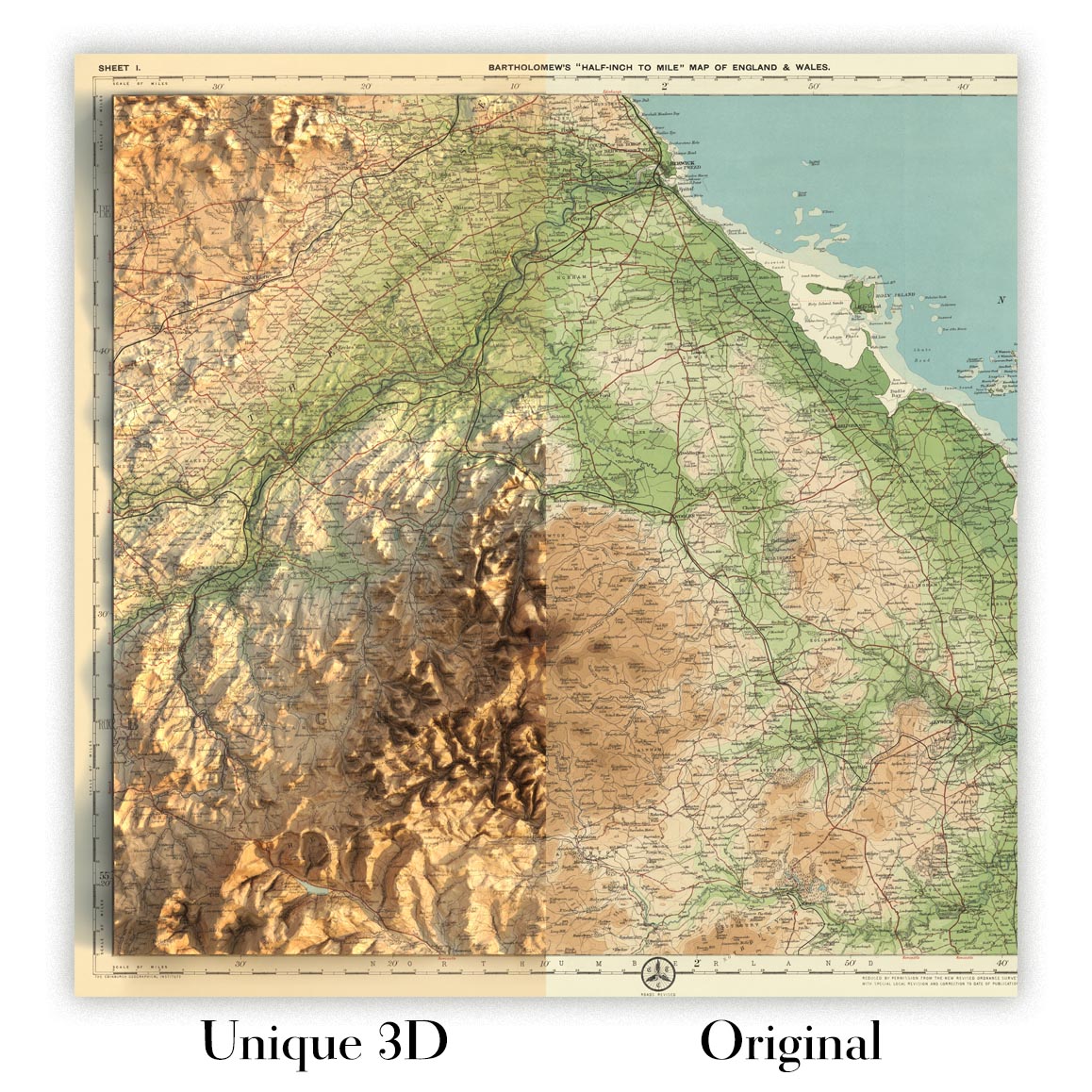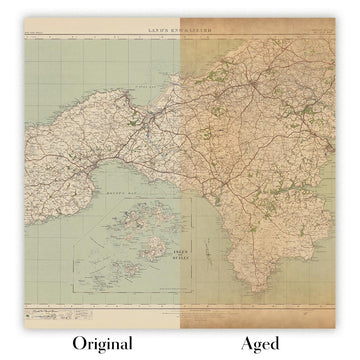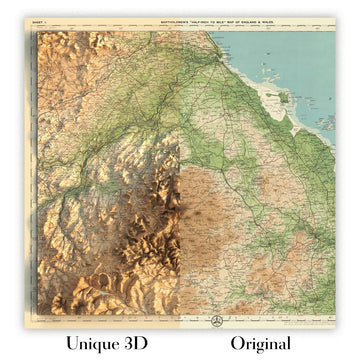- Handmade locally. No import duty or tax
- FREE Delivery by Christmas
- Love it or your money back (90 days)
- Questions? WhatsApp me any time
Own a piece of history
5,000+ 5 star reviews


Step into the captivating world of early 20th-century cartography with "Sheet 36 - South Devon," a masterful creation by the renowned JG Bartholomew. This exquisite map, produced in 1901, epitomizes the elegance and precision of Bartholomew's work, which became the hallmark of his celebrated half-inch to the mile series. Designed with cyclists and tourists in mind, this map offers a vivid portrayal of South Devon, combining both political and physical features in a visually stunning and informative manner. The meticulous use of colour bands to depict landscape relief showcases Bartholomew's innovative approach to cartography, making this map not only a navigational tool but also a work of art.
The mapmaker, JG Bartholomew, was a distinguished Scottish cartographer whose contributions to the field were both prolific and influential. Known for his attention to detail and aesthetic sensibility, Bartholomew's maps were highly regarded for their clarity and beauty. His work on the half-inch series, including this map of South Devon, was particularly significant as it catered to the burgeoning interest in outdoor activities such as cycling and hiking. Bartholomew's legacy in cartography is evident in the enduring appeal of his maps, which continue to be cherished by collectors and enthusiasts alike.
This map of South Devon is a treasure trove of geographical and historical information. It features a detailed representation of the region's topography, with the rugged terrain of Dartmoor National Park prominently displayed. The map also highlights the intricate network of rivers, including the Dart, Teign, and Exe, which meander through the lush countryside before emptying into the English Channel. Coastal features such as Start Point, Bolt Head, and Berry Head are meticulously marked, providing a comprehensive view of South Devon's diverse landscape. The use of colour gradation to indicate elevation adds depth and dimension, making the map both informative and visually appealing.
In addition to its physical features, the map also provides a snapshot of South Devon's human settlements at the turn of the 20th century. Cities and towns such as Exeter, Torquay, Paignton, and Newton Abbot are clearly marked, offering a glimpse into the region's urban landscape. Smaller towns like Totnes, Ivybridge, and Tavistock are also featured, reflecting the rich tapestry of communities that make up South Devon. The map's detailed depiction of roads and railways underscores the importance of transportation networks in connecting these settlements, facilitating travel and commerce in the region.
The historical significance of this map extends beyond its geographical accuracy. It serves as a window into a bygone era, capturing the essence of South Devon at a time when the region was becoming increasingly accessible to tourists and adventurers. The map's design and execution reflect the technological advancements and artistic sensibilities of the early 20th century, making it a valuable artifact for historians and collectors. Whether you are drawn to its aesthetic beauty, historical context, or geographical detail, "Sheet 36 - South Devon" by JG Bartholomew is a remarkable piece that embodies the artistry and precision of classic cartography.
Cities and towns on this map
- Exeter (Modern-day population: ~130,000)
- Torquay (Modern-day population: ~65,000)
- Paignton (Modern-day population: ~50,000)
- Newton Abbot (Modern-day population: ~25,000)
- Exmouth (Modern-day population: ~35,000)
- Teignmouth (Modern-day population: ~15,000)
- Dawlish (Modern-day population: ~13,000)
- Totnes (Modern-day population: ~8,000)
- Ivybridge (Modern-day population: ~12,000)
- Tavistock (Modern-day population: ~12,000)
- Brixham (Modern-day population: ~16,000)
- Kingsbridge (Modern-day population: ~6,000)
- Salcombe (Modern-day population: ~2,000)
- Dartmouth (Modern-day population: ~5,000)
- Ashburton (Modern-day population: ~4,000)
- Okehampton (Modern-day population: ~7,000)
Notable Features & Landmarks
- Dartmoor National Park
- Exe Estuary
- Teign Estuary
- Dart Estuary
- River Dart
- River Teign
- River Exe
- Start Point (prominent coastal feature)
- Bolt Head (prominent coastal feature)
- Berry Head (prominent coastal feature)
- Haldon Hills
- Blackdown Hills
- South Hams (area of outstanding natural beauty)
- Salcombe (estuary and coastal area)
- Kingsbridge Estuary
- Slapton Sands (beach and nature reserve)
- Torbay (bay area)
- Lyme Bay (bay area)
- Exmouth (coastal area)
Historical and design context
- Name of the map: Sheet 36 - South Devon
- Scale and usage: A clear, attractive, and colourful map at the half-inch to the mile scale (1:126,720). These maps were popular with cyclists and tourists, and became Bartholomew's flagship series.
- Landscape relief representation: The half-inch maps were distinctive for using different layers of colour to represent landscape relief, with a subtle and innovative gradation of colour bands used to show land at different heights.
- Base map: The map is based on a reduced Ordnance Survey map from the same period.
- Creation date: 1901
- Mapmaker or publisher: JG Bartholomew
- Context about the mapmaker: JG Bartholomew was a prominent Scottish cartographer known for his detailed and aesthetically pleasing maps. His work significantly influenced the field of cartography during his time.
- Themes shown on the map: The map details political and physical features, including topography, roads, railways, rivers, and coastal areas. It also highlights the landscape relief through colour gradation.
- Regions shown on the map: This map covers the South Devon region of England.
- Design and style: The map is designed in a landscape orientation, measuring approximately 36 miles from north to south and 52 miles from west to east. It features a detailed and colourful representation of the terrain, with distinct colour bands indicating different elevations.
- Historical significance: This map is part of Bartholomew's innovative series that catered to the growing popularity of cycling and tourism in the early 20th century. It reflects the advancements in cartographic techniques and the increased interest in detailed and accessible maps for the general public.
Please double check the images to make sure that a specific town or place is shown on this map. You can also get in touch and ask us to check the map for you.
This map looks great at every size, but I always recommend going for a larger size if you have space. That way you can easily make out all of the details.
This map looks amazing at sizes all the way up to 70in (180cm). If you are looking for a larger map, please get in touch.
Please note: the labels on this map are hard to read if you order a map that is 20in (50cm) or smaller. The map is still very attractive, but if you would like to read the map easily, please buy a larger size.
The model in the listing images is holding the 18x24in (45x60cm) version of this map.
The fifth listing image shows an example of my map personalisation service.
If you’re looking for something slightly different, check out my collection of the best old maps to see if something else catches your eye.
Please contact me to check if a certain location, landmark or feature is shown on this map.
This would make a wonderful birthday, Christmas, Father's Day, work leaving, anniversary or housewarming gift for someone from the areas covered by this map.
This map is available as a giclée print on acid free archival matte paper, or you can buy it framed. The frame is a nice, simple black frame that suits most aesthetics. Please get in touch if you'd like a different frame colour or material. My frames are glazed with super-clear museum-grade acrylic (perspex/acrylite), which is significantly less reflective than glass, safer, and will always arrive in perfect condition.
This map is also available as a float framed canvas, sometimes known as a shadow gap framed canvas or canvas floater. The map is printed on artist's cotton canvas and then stretched over a handmade box frame. We then "float" the canvas inside a wooden frame, which is available in a range of colours (black, dark brown, oak, antique gold and white). This is a wonderful way to present a map without glazing in front. See some examples of float framed canvas maps and explore the differences between my different finishes.
For something truly unique, this map is also available in "Unique 3D", our trademarked process that dramatically transforms the map so that it has a wonderful sense of depth. We combine the original map with detailed topography and elevation data, so that mountains and the terrain really "pop". For more info and examples of 3D maps, check my Unique 3D page.
For most orders, delivery time is about 3 working days. Personalised and customised products take longer, as I have to do the personalisation and send it to you for approval, which usually takes 1 or 2 days.
Please note that very large framed orders usually take longer to make and deliver.
If you need your order to arrive by a certain date, please contact me before you order so that we can find the best way of making sure you get your order in time.
I print and frame maps and artwork in 23 countries around the world. This means your order will be made locally, which cuts down on delivery time and ensures that it won't be damaged during delivery. You'll never pay customs or import duty, and we'll put less CO2 into the air.
All of my maps and art prints are well packaged and sent in a rugged tube if unframed, or surrounded by foam if framed.
I try to send out all orders within 1 or 2 days of receiving your order, though some products (like face masks, mugs and tote bags) can take longer to make.
If you select Express Delivery at checkout your order we will prioritise your order and send it out by 1-day courier (Fedex, DHL, UPS, Parcelforce).
Next Day delivery is also available in some countries (US, UK, Singapore, UAE) but please try to order early in the day so that we can get it sent out on time.
My standard frame is a gallery style black ash hardwood frame. It is simple and quite modern looking. My standard frame is around 20mm (0.8in) wide.
I use super-clear acrylic (perspex/acrylite) for the frame glass. It's lighter and safer than glass - and it looks better, as the reflectivity is lower.
Six standard frame colours are available for free (black, dark brown, dark grey, oak, white and antique gold). Custom framing and mounting/matting is available if you're looking for something else.
Most maps, art and illustrations are also available as a framed canvas. We use matte (not shiny) cotton canvas, stretch it over a sustainably sourced box wood frame, and then 'float' the piece within a wood frame. The end result is quite beautiful, and there's no glazing to get in the way.
All frames are provided "ready to hang", with either a string or brackets on the back. Very large frames will have heavy duty hanging plates and/or a mounting baton. If you have any questions, please get in touch.
See some examples of my framed maps and framed canvas maps.
Alternatively, I can also supply old maps and artwork on canvas, foam board, cotton rag and other materials.
If you want to frame your map or artwork yourself, please read my size guide first.
My maps are extremely high quality reproductions of original maps.
I source original, rare maps from libraries, auction houses and private collections around the world, restore them at my London workshop, and then use specialist giclée inks and printers to create beautiful maps that look even better than the original.
My maps are printed on acid-free archival matte (not glossy) paper that feels very high quality and almost like card. In technical terms the paper weight/thickness is 10mil/200gsm. It's perfect for framing.
I print with Epson ultrachrome giclée UV fade resistant pigment inks - some of the best inks you can find.
I can also make maps on canvas, cotton rag and other exotic materials.
Learn more about The Unique Maps Co.
Map personalisation
If you're looking for the perfect anniversary or housewarming gift, I can personalise your map to make it truly unique. For example, I can add a short message, or highlight an important location, or add your family's coat of arms.
The options are almost infinite. Please see my map personalisation page for some wonderful examples of what's possible.
To order a personalised map, select "personalise your map" before adding it to your basket.
Get in touch if you're looking for more complex customisations and personalisations.
Map ageing
I have been asked hundreds of times over the years by customers if they could buy a map that looks even older.
Well, now you can, by selecting Aged before you add a map to your basket.
All the product photos you see on this page show the map in its Original form. This is what the map looks like today.
If you select Aged, I will age your map by hand, using a special and unique process developed through years of studying old maps, talking to researchers to understand the chemistry of aging paper, and of course... lots of practice!
If you're unsure, stick to the Original colour of the map. If you want something a bit darker and older looking, go for Aged.
If you are not happy with your order for any reason, contact me and I'll get it fixed ASAP, free of charge. Please see my returns and refund policy for more information.
I am very confident you will like your restored map or art print. I have been doing this since 1984. I'm a 5-star Etsy seller. I have sold tens of thousands of maps and art prints and have over 5,000 real 5-star reviews. My work has been featured in interior design magazines, on the BBC, and on the walls of dozens of 5-star hotels.
I use a unique process to restore maps and artwork that is massively time consuming and labour intensive. Hunting down the original maps and illustrations can take months. I use state of the art and eye-wateringly expensive technology to scan and restore them. As a result, I guarantee my maps and art prints are a cut above the rest. I stand by my products and will always make sure you're 100% happy with what you receive.
Almost all of my maps and art prints look amazing at large sizes (200cm, 6.5ft+) and I can frame and deliver them to you as well, via special oversized courier. Contact me to discuss your specific needs.
Or try searching for something!







